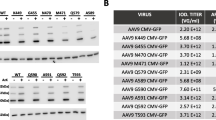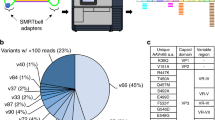Abstract
The ability to modify the capsid proteins of human viruses is desirable both for installing probes to study their structure and function, and to attach retargeting agents to engineer viral infectivity. However, the installation of such capsid modifications currently faces two major challenges: (1) The complex and delicate capsid proteins often do not tolerate large modifications, and (2) capsid proteins are composed of the 20 canonical amino acids, precluding site-specific chemical modification of the virus. Here, we describe a technology for generating adeno-associated virus (AAV) while incorporating an unnatural amino acid (UAA) into specific sites of the virus capsid. Incorporation of this UAA is generally tolerated well, presumably due to its small structural footprint. The resulting virus can be precisely functionalized at the site of UAA incorporation using chemoselective conjugation strategies targeted toward the azido side chain of this UAA. This technology provides a powerful way to modify AAV with unprecedented precision to both probe and engineer its entry process.
Access this chapter
Tax calculation will be finalised at checkout
Purchases are for personal use only
Similar content being viewed by others
References
Samulski RJ, Muzyczka N (2014) AAV-mediated gene therapy for research and therapeutic purposes. Annu Rev Virol 1:427–451. https://doi.org/10.1146/annurev-virology-031413-085355
Mingozzi F, High KA (2011) Therapeutic in vivo gene transfer for genetic disease using AAV: progress and challenges. Nat Rev Genet 12:341–355. https://doi.org/10.1038/nrg2988
Kotterman MA, Schaffer DV (2014) Engineering adeno-associated viruses for clinical gene therapy. Nat Rev Genet 15:445–451. https://doi.org/10.1038/nrg3742
Agbandje-McKenna M, Kleinschmidt J (2011) AAV capsid structure and cell interactions. Methods Mol Biol 807:47–92. https://doi.org/10.1007/978-1-61779-370-7_3
Douar AM, Poulard K, Danos O (2003) Deleterious effect of peptide insertions in a permissive site of the AAV2 capsid. Virology 309:203–208
Horowitz ED, Weinberg MS, Asokan A (2011) Glycated AAV vectors: chemical redirection of viral tissue tropism. Bioconjug Chem 22:529–532. https://doi.org/10.1021/bc100477g
Liu Y, Fang Y, Zhou Y, Zandi E, Lee CL, Joo KI, Wang P (2013) Site-specific modification of adeno-associated viruses via a genetically engineered aldehyde tag. Small 9:421–429. https://doi.org/10.1002/smll.201201661
Shi W, Bartlett JS (2003) RGD inclusion in VP3 provides adeno-associated virus type 2 (AAV2)-based vectors with a heparan sulfate-independent cell entry mechanism. Mol Ther 7:515–525
Stachler MD, Chen I, Ting AY, Bartlett JS (2008) Site-specific modification of AAV vector particles with biophysical probes and targeting ligands using biotin ligase. Mol Ther 16:1467–1473. https://doi.org/10.1038/mt.2008.129
Dumas A, Lercher L, Spicer CD, Davis BG (2015) Designing logical codon reassignment—expanding the chemistry in biology. Chem Sci 6:50–69
Liu CC, Schultz PG (2010) Adding new chemistries to the genetic code. Annu Rev Biochem 79:413–444. https://doi.org/10.1146/annurev.biochem.052308.105824
Kelemen RE, Mukherjee R, Cao X, Erickson SB, Zheng Y, Chatterjee A (2016) A precise chemical strategy to alter the receptor specificity of the adeno-associated virus. Angew Chem Int Ed Engl 55:10645–10649. https://doi.org/10.1002/anie.201604067
Chatterjee A, Xiao H, Bollong M, Ai HW, Schultz PG (2013) Efficient viral delivery system for unnatural amino acid mutagenesis in mammalian cells. Proc Natl Acad Sci U S A 110:11803–11808. https://doi.org/10.1073/pnas.1309584110
Erickson SB, Mukherjee R, Kelemen RE, Wrobel CJJ, Cao X, Chatterjee A (2017) Precise photoremovable perturbation of a virus–host interaction. Angew Chem Int Ed Engl 56:4234–4237. doi: 10.1002/anie.201700683
Auricchio A, Hildinger M, O’Connor E, Gao GP, Wilson JM (2001) Isolation of highly infectious and pure adeno-associated virus type 2 vectors with a single-step gravity-flow column. Hum Gene Ther 12:71–76. https://doi.org/10.1089/104303401450988
Zheng Y, Lewis TL Jr, Igo P, Polleux F, Chatterjee A (2016) Virus-enabled optimization and delivery of the genetic machinery for efficient unnatural amino acid mutagenesis in mammalian cells and tissues. ACS Synth Biol 6:13. https://doi.org/10.1021/acssynbio.6b00092
van Geel R, Pruijn GJ, van Delft FL, Boelens WC (2012) Preventing thiol-yne addition improves the specificity of strain-promoted azide-alkyne cycloaddition. Bioconjug Chem 23:392–398. https://doi.org/10.1021/bc200365k
Author information
Authors and Affiliations
Corresponding author
Editor information
Editors and Affiliations
Rights and permissions
Copyright information
© 2018 Springer Science+Business Media, LLC
About this protocol
Cite this protocol
Kelemen, R.E., Erickson, S.B., Chatterjee, A. (2018). Production and Chemoselective Modification of Adeno-Associated Virus Site-Specifically Incorporating an Unnatural Amino Acid Residue into Its Capsid. In: Lemke, E. (eds) Noncanonical Amino Acids. Methods in Molecular Biology, vol 1728. Humana Press, New York, NY. https://doi.org/10.1007/978-1-4939-7574-7_20
Download citation
DOI: https://doi.org/10.1007/978-1-4939-7574-7_20
Published:
Publisher Name: Humana Press, New York, NY
Print ISBN: 978-1-4939-7573-0
Online ISBN: 978-1-4939-7574-7
eBook Packages: Springer Protocols




